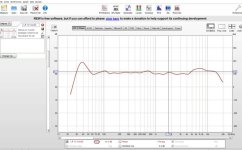test SPL and adjust speaker, dsp, environemn, test and adjust, test and adjust......
finally, the SPL looks smooth......
in the beginning, without diffusion block board

after diffusion block board on the wall, looks much better, only one big peak in 38Hz, it is always easy to handle the peak, but hard for the valley

cut off the peak in 38Hz, the SPL looks vey smooth

finally, the SPL looks smooth......
in the beginning, without diffusion block board
after diffusion block board on the wall, looks much better, only one big peak in 38Hz, it is always easy to handle the peak, but hard for the valley
cut off the peak in 38Hz, the SPL looks vey smooth
Attachments
I hope you have capacitors on the true ribbons. If not, you'll short out your tweeter channel amp.
it is very complex, I did lots of testing for the horn shape, finally, that shape make SPL very flat, and sounds very smooth, it is really some different between theory and practice.I have a question about this picture:
View attachment 1202615
I know that the beginning of the horn/waveguide should be as close as possible to the sound outlets or the diaphragms. Otherwise you would get a reflection chaos. Why has this been done differently here? Have these combinations of drivers and waveguides ever been examined metrologically?
An example of an AMT with waveguide from Beyma, image from Vance Dickason's Audioxpress Test Bench:
View attachment 1202619
Many greetings,
Michael
Thanks for your informaiton, but I do not quite understand, I use minidsp flex 8 to seperate the frequencies to different speaker unit, is there anything I need to take care?I hope you have capacitors on the true ribbons. If not, you'll short out your tweeter channel amp.
A real ribbon-tweeter like the Neo CD 3.0 would have a resistance of close to 0 ohms without an output transformer, with its built-in output transformer this only applies to the lower frequency range, which must therefore be filtered out with a capacitor so that the responsible power amplifier does not "see" a short circuit.
But as you already wrote:
"it is really some different between theory and practice."
So try it out. 😉
Many greetings,
Michael
But as you already wrote:
"it is really some different between theory and practice."
So try it out. 😉
Many greetings,
Michael
Yes you are right, Neo 3.0 present good performance in high frequency.
JBL 076 prensent decrease after 15k.
so that I use a 1.5uf capacitance to simpley seperate around 15k to Neo 3.0, this will make the SPL higher and sounds better after 15k.
bty, my system is DSP to seperate 4 ways + 1 way with capacitance for HF.
JBL 076 prensent decrease after 15k.
so that I use a 1.5uf capacitance to simpley seperate around 15k to Neo 3.0, this will make the SPL higher and sounds better after 15k.
bty, my system is DSP to seperate 4 ways + 1 way with capacitance for HF.
try to record some videos, with iPhone smartphone, the videos are just so so, can not reflect voice in the locale
https://www.bilibili.com/video/B ... ommend_more_video.0
https://www.bilibili.com/video/B ... ommend_more_video.3
https://www.bilibili.com/video/B ... ff66dd12f7342fa890f
https://www.bilibili.com/video/B ... ff66dd12f7342fa890f
https://www.bilibili.com/video/B ... ff66dd12f7342fa890f
https://www.bilibili.com/video/B ... ommend_more_video.0
https://www.bilibili.com/video/B ... ommend_more_video.3
https://www.bilibili.com/video/B ... ff66dd12f7342fa890f
https://www.bilibili.com/video/B ... ff66dd12f7342fa890f
https://www.bilibili.com/video/B ... ff66dd12f7342fa890f
Yes, this speaker sounds prefect, I will upload some videos later
update videos
交响乐
https://www.douyin.com/user/self?modal_id=7286666933221543183&showTab=post
Somewhere Somebody
https://www.douyin.com/user/self?modal_id=7285293573979852084&showTab=post
I don't hurt anymore
https://www.douyin.com/user/self?modal_id=7284062932411944207&showTab=post
春江花月夜
https://www.douyin.com/user/self?modal_id=7284256315067698467&showTab=post
凤鸣山之战
https://www.douyin.com/user/self?modal_id=7285987001159929128&showTab=post
女人花
https://www.douyin.com/user/self?modal_id=7284257189282303266&showTab=post
落雨飞沙
https://www.douyin.com/user/self?modal_id=7285936316913650984&showTab=post
故乡的云
https://www.douyin.com/user/self?modal_id=7285294449788226851&showTab=post
军港之夜
https://www.douyin.com/user/self?modal_id=7284252765851847976&showTab=post
送别
https://www.douyin.com/user/self?modal_id=7284253192227982626&showTab=post
交响乐
https://www.douyin.com/user/self?modal_id=7286666933221543183&showTab=post
Somewhere Somebody
https://www.douyin.com/user/self?modal_id=7285293573979852084&showTab=post
I don't hurt anymore
https://www.douyin.com/user/self?modal_id=7284062932411944207&showTab=post
春江花月夜
https://www.douyin.com/user/self?modal_id=7284256315067698467&showTab=post
凤鸣山之战
https://www.douyin.com/user/self?modal_id=7285987001159929128&showTab=post
女人花
https://www.douyin.com/user/self?modal_id=7284257189282303266&showTab=post
落雨飞沙
https://www.douyin.com/user/self?modal_id=7285936316913650984&showTab=post
故乡的云
https://www.douyin.com/user/self?modal_id=7285294449788226851&showTab=post
军港之夜
https://www.douyin.com/user/self?modal_id=7284252765851847976&showTab=post
送别
https://www.douyin.com/user/self?modal_id=7284253192227982626&showTab=post
- Home
- Loudspeakers
- Multi-Way
- The first DIY loudspeaker I am working on
